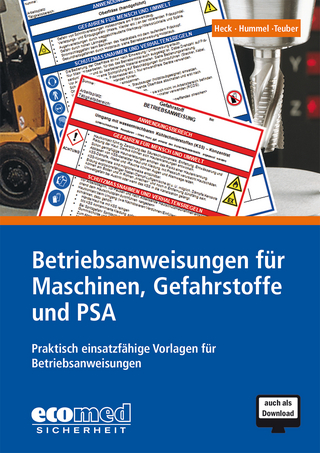
Revalidating Process Hazard Analyses
Wiley-Blackwell (Hersteller)
978-0-470-93553-8 (ISBN)
- Keine Verlagsinformationen verfügbar
- Artikel merken
Walter L. Frank is the author of Revalidating Process Hazard Analyses, published by Wiley. David K. Whittle is the author of Revalidating Process Hazard Analyses, published by Wiley.
Preface. Acknowledgments. Glossary. Acronyms and Abbreviations. Introduction. Why Was This Book Written? Scope of This Book. The CCPS Workshop. How This Book Is Organized. Chapter 1. Refresher on the Basics. 1.1 What a PHA IS Intended to Accomplish. 1.2 Brief Review of the More Common PHA Methodologies. 1.3 PHA Team Make-Up. Chapter 2. Revalidation-What IS It? 2.1 The Reason for Revalidation. 2.2 Revalidation Objective. 2.3 Revalidation Concept. 2.4 Establishing the Revalidation Schedule. 2.5 The Role of a Revalidation Procedure. Chapter 3. Preparing for the Revalidation Study. 3.1 Preplan the Revalidation. 3.1.1 Establishing the Scope of the Revalidation. 3.1.2 Selection of Team Members. 3.1.3 Scheduling-Estimating Time and Resources. 3.2 Identify, Collect, and Prepare Needed Information. 3.2.1 Determining Information Requirements. 3.2.2 Distribution of Information. 3.3 Review and Analyze Information. 3.3.1 Prior PHA Report(s) and Related Documentation. 3.3.2 Resolution Completion Report for Prior PHA Recommendations. 3.3.3 MOC and PSSR Documentation. 3.3.4 PSM System Audit Results. 3.3.5 Incident and Near-Miss Reports. 3.3.6 Piping and Instrument Diagrams (P&IDs). 3.3.7 Operating Procedures. Chapter 4. Evaluating the Prior PHA Study. 4.1 Evaluation of the PHA with Respect to Essential Criteria. 4.1.1 PHA Rigor. 4.1.2 Methodology Used. 4.1.3 Team Make-Up. 4.1.4 Documentation. 4.1.5 Drawing the Conclusions. 4.2 Evaluation of PHA Quality and Completeness. 4.3 Other Considerations. 4.4 Common Problems with PHAs. Chapter 5. Identifying Changes That Have Occurred Since the Prior PHA. 5.1 Logging the Identified Changes. 5.2 Documented and Controlled Changes. 5.2.1 MOC and PSSR Review. 5.2.2 P&ID Comparison. 5.2.3 Procedure Reviews. 5.2.4 PHA and Incident Investigation Recommendations. 5.3 Undocumented and Uncontrolled Changes. 5.3.1 Interviews of Facility Personnel. 5.3.2 Maintenance Records. 5.3.3 Purchase Specifications and Records. 5.3.4 Incident Investigation Reports. 5.5.5 PSM Program Audits. Chapter 6. Identifying an Appropriate Revalidation Methodology. 6.1 Revalidation Options. 6.1.1 Update and Revalidate. 6.1.2 Retrofit, Update, and Revalidate. 6.1.3 Redo. 6.2 Selecting the Revalidation Option. Chapter 7. Conducting the Revalidation Study Sessions. 7.1 Team Training. 7.2 Application of Revalidation methodology. 7.3 Special Topics. 7.3.1 Staying Productive. 7.3.2 Facility (or Stationary Source) Siting. 7.3.3 Human Factors. 7.3.4 Wrap-Up Discussions. Chapter 8. Documenting the Revalidation Study. 8.1 Documentation Approaches. 8.2 Report and Its Content. 8.3 Recommendation Follow-Up. 8.4 Records Retention and Distribution. Appendix A. Federal Regulatory Requirements. Appendix B. Essential Criteria Checklist. Appendix C. PHA Quality and Completeness Checklist. Appendix D. Example Change Summary Worksheet. Appendix E. Facility and Process Modification Checklist. Appendix F. Facility and Stationary Source Siting Checklist. Appendix G. Human Factors Checklist. Bibliography. Index.
| Erscheint lt. Verlag | 31.8.2010 |
|---|---|
| Verlagsort | Hoboken |
| Sprache | englisch |
| Maße | 161 x 232 mm |
| Gewicht | 382 g |
| Themenwelt | Naturwissenschaften ► Chemie ► Technische Chemie |
| Technik | |
| Wirtschaft | |
| ISBN-10 | 0-470-93553-7 / 0470935537 |
| ISBN-13 | 978-0-470-93553-8 / 9780470935538 |
| Zustand | Neuware |
| Informationen gemäß Produktsicherheitsverordnung (GPSR) | |
| Haben Sie eine Frage zum Produkt? |
aus dem Bereich
